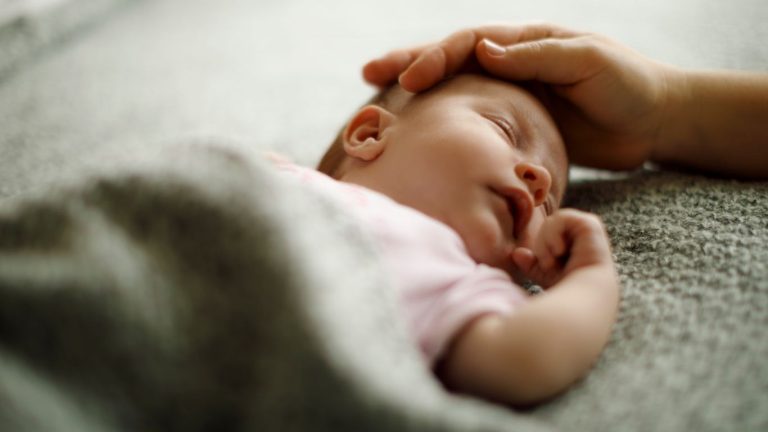While baby hammocks were once seen as quite alternative, baby hammocks are now popular with mainstream maternity carers and parents from all walks of life.
What is a baby hammock?
Just as the name suggests, a baby hammock is literally a hammock for babies. Made from natural breathable fibres, the hammock (or cocoon) is attached to a wooden pole and hangs from the ceiling, door frame or freestanding stand. A woolen futon mattress is inserted into the hammock to ensure a safe and comfortable sleep for your baby.
A baby hammock is NOT a mini version of an adult hammock, but a specially designed sleeping bed for babies.
Are baby hammocks safe?
If properly designed, constructed and used, then a baby hammock may be a safe sleeping option for babies from birth to about 18 months old. We know of no NZ safety regulations specifically for baby hammocks, but individual manufacturers adhere to voluntary standards and should be more than happy to share their testing results with you.
Be wary of poorly designed and constructed hammocks. In 2009 the principal hammock manufacturer in the US recalled 24,000 hammocks.
Some key safety aspects to consider include:
How much weight will the hammock hold?
Popular brands in New Zealand hold up to 15kg (33lbs) and are rigorously tested for strength.
What is the hammock made from?
The baby hammock should be made from natural breathable fibres, to ensure a safe breathing environment for baby. Natural, unbleached calico is a popular and safe choice and as a bonus it is hard wearing and easy to wash.
Please note: Hammocks made from netting or string are not true baby hammocks and can (and probably will!) cause serious harm to your child.
What is the mattress made from?
A hammock mattress must be made from natural materials and be firm enough to support baby while still providing a natural cradle. The mattress should be bought with the hammock to ensure it is exactly the right fit.
How is it designed?
Research shows that the safest sleeping position for babies is on their back, as part of cot death prevention. Properly designed baby hammocks make it impossible for baby to roll over onto their tummies. When purchasing a baby hammock, check that it has been designed as a baby sleeping hammock and not just a mini version of a grown up lounger.
What type of springs and clips are used for baby hammocks?
Different brands use different types of springs and clips in the hanging mechanism of their hammocks. All springs and clips should be tested for strength and be suitably covered to avoid injury.
Benefits of using a baby hammock
There is no doubt about it, parents who use baby hammocks all attest to getting a good nights sleep and leading maternity caregivers “Birthcare” also endorse baby hammocks as a safe, effective sleeping option for babies. Some of the main benefits of using a baby hammock are:
- Baby hammocks provide your child with a cradled environment which feels similar to being in the womb. The familiar feeling provides a sense of security for your baby and promotes a settled sleep.
- A baby hammock helps to evenly distribute your baby’s weight, causing less stress on muscles and joints, minimising the risk of ‘flat head’.
- Baby hammocks naturally cause baby to sleep with their head slightly elevated. This is particularly helpful for babies with chronic reflux.
- Properly designed hammocks keep babies sleeping on their back – the safest sleeping position for babies.
- Baby can be easily settled back to sleep by a gentle swinging of the hammock. As baby grows and begins to wiggle on their own, the movement of the hammock means baby will often settle themselves back to sleep.
- Baby hammocks are completely portable. No matter where you are staying, baby gets to sleep in their own familiar bed. They are lightweight and take up less space than a traditional portacot.
Potential downsides of using a baby hammock
There seem to be few (if any) downsides to using a baby hammock, particularly when baby is very young. However, if you choose to purchase a baby hammock, you may want to keep in mind the following:
- As baby learns to crawl or stand, they may try to escape their cocoon. Properly designed hammocks make it very difficult for babies to climb out but, just as with cots, there will be the odd child who manages to clamber out. Make sure your hammock is hanging somewhere safe should your Houdini try to “make a run for it”.
- Even though hammocks have been around for centuries, some well-meaning (but uninformed) friends may criticise your decision and question the safety and appropriateness of using a hammock. Welcome to parenthood! Feel secure that you have researched your decision and it is only your decision to make. If you want to, provide them with your research, but above all else trust yourself and know that you have made the decision based on what is right for you and your family.
How much do baby hammocks cost?
Baby hammocks vary in price depending on the brand, but range between $180 – $250 for a complete start up set. Start-up packages usually include the hammock, mattress, hooks and door clamp. Extra clamps, hooks and accessories, such as mosquito nets or mattress covers, can be purchased separately for $10 – $20 a piece. Free standing frames range between $120 – $160.
Can I buy a baby hammock second hand?
Of course you can, but make sure you check out every aspect for safety. Check clips, springs, fabric and stitching for any wear and tear and if you have any concerns at all – buy new.
Check out our directory for more information, and to find New Zealand trusted stockists of Baby Hammocks.





